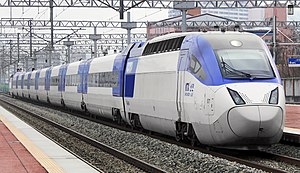| KTX | |||||
|---|---|---|---|---|---|
 KTX-Sancheon | |||||
| Overview | |||||
| Service type | |||||
| Status | Operating | ||||
| Locale | South Korea | ||||
| Current operator(s) | Korail | ||||
| On-board services | |||||
| Class(es) |
| ||||
| Disabled access | Fully accessible | ||||
| Catering facilities | Yes | ||||
| Entertainment facilities | Yes | ||||
| Baggage facilities | Yes | ||||
| Technical | |||||
| Rolling stock | |||||
| Track gauge | 1,435 mm (4 ft 8+1⁄2 in) Standard gauge | ||||
| Operating speed | Up to 305 km/h (190 mph) | ||||
| Korean name | |||||
| Hangul | |||||
| Hanja | |||||
| Revised Romanization | Hanguk Gosok Cheoldo | ||||
| McCune–Reischauer | Hanguk Kosok Ch'ŏlto | ||||
| |||||
Korea Train eXpress (Korean: 한국고속철도), often known as KTX (Korean: 케이티엑스; RR: Keitiekseu), is South Korea's high-speed rail system, operated by Korail. Construction began on the high-speed line from Seoul to Busan in 1992. KTX services were launched on April 1, 2004.
From Seoul Station the KTX lines radiate with stops at Seoul Station, Yongsan station towards Busan and Gwangju. A new line from Wonju to Gangneung was completed in December 2017 to serve the 2018 Winter Olympics in Pyeongchang.
The current maximum operating speed for trains in regular service is 305 km/h (190 mph), though the infrastructure is designed for 350 km/h (217 mph). The initial rolling stock was based on Alstom's TGV Réseau, and was partly built in Korea. The domestically developed HSR-350x, which achieved 352.4 km/h (219.0 mph) in tests, resulted in a second type of high-speed trains now operated by Korail, the KTX Sancheon. The next generation KTX train, HEMU-430X, achieved 421.4 km/h in 2013, making South Korea the world's fourth country after Japan, France and China to develop a high-speed train running on conventional rail above 420 km/h.
In June 2024, South Korea and Uzbekistan concluded a KRW 270 billion (approximately US$196 million) deal to apply KTX technology in Uzbekistan by supplying high-speed trains and Korail expertise.[1][2]
- ^ "High-speed rail KTX to see first export via Uzbekistan deal". Korea.net. 17 June 2024. Archived from the original on 18 June 2024. Retrieved 7 November 2024.
- ^ "(LEAD) Hyundai Rotem secures 1st high-speed train export deal in Uzbekistan". Yonhap News Agency. 14 June 2024. Archived from the original on 14 June 2024. Retrieved 7 November 2024.
